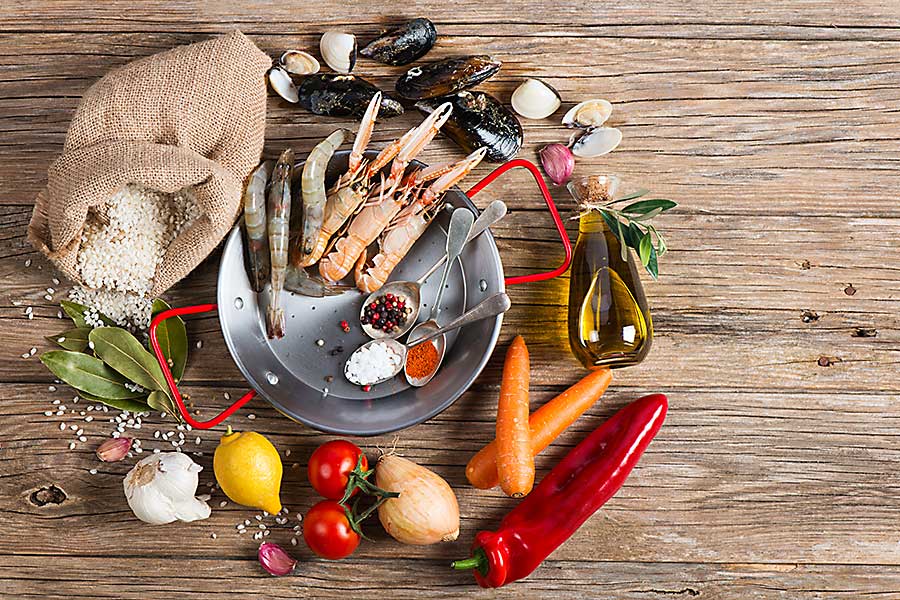Paella
Paella is a type of rice dish that originated in the Spanish region of Valencia. It is one of the best known dishes in Spanish cuisine. That said, while many people consider paella to be the Spanish national dish, Spaniards themselves consider it as more of a Valencian meal. There are hundreds of recipes for paella in existence, each one with varying ingredients and recipes. However the dish is characterised – and named for – the wide, shallow pan that is used to cook the rice on an open fire. You cannot have a paella without using a paella pan. Paella itself is the Valencian word for frying pan.
The only ingredients needed to make a ‘true’ and simple paella are rice, tomatoes, and saffron. These form the base of a traditional Valencian paella. Other ingredients may then be added to the dish, including chorizo, chicken, mussels, squid, peppers, and green beans. More elaborate preparations exist all over the world, some including ingredients like shrimp, lobster, and duck. Food historian, Loudes March, says that paella is symbolic of the union of two important cultures: Roman and Arab.
History of paella
Rice was introduced to Spain by the Muslim Moors of Andalusia during the 10th century. Over time, it became common for locals of the Iberian Peninsula to cook lightly spiced rice and fish casseroles. By the time of the 15th century, rice had become a staple of the region’s cuisine, paving the way for paella to make its entrance. Over time, locals began to combine these rice dishes with vegetables, beans, and dry cod, especially during religious festivals like Lent.
In the early 18th century, Valencian locals used cauldrons to cook rice in the open air of their farms. During this period they introduced meats to the traditional recipe, particularly that of water vole and eel. During the 19th century, Spanish living standards and social conditions improved. This meant that people were able to have more food gatherings and outings. Eventually, this led to an evolution of the ingredients used in the traditional paella.
Different meats were added to the classic recipe, including rabbit, chicken, duck, and occasionally snail. As the rice casseroles increased in popularity amongst the Valencians, they were dubbed paella. The name paella is Valencian for pan. The first usage of the term referring to a recipe and not a frying pan is in a Spanish newspaper in 1840. Some argue that the word paella actually evolved from the Arabic term, baqayya, which means leftovers. It’s said that the term came to use from the servants of Moorish kings. The servants would take home leftovers from the royals’ dinner, typically rice casseroles like paella.
Traditional paella ingredients
The most popular ingredients used to make a traditional paella were short-grain white rice, meat such as chicken, rabbit, snail or duck, butter beans, great northern beans, runner beans, artichokes, tomatoes, fresh rosemary, sweet paprika, saffron, garlic, salt, and olive oil. Seafood was later introduced to the paella recipe by Valencian locals from the Mediterranean coast. They traded the common meats and beans to make their paella with shelled seafood. A variation also exists with unshelled seafood, called paella del senyoret.
Eventually, Spaniards living outside of Valencia combined the two ingredient lists to make a mixed paella with both meat and seafood. This is sometimes referred to as a preparacion barroca paella. Local Valencians from poorer areas make their paella with just snail meat.
How to make paella Valenciana
This is a basic standardised recipe for Valencian paella. The dish is very dear to Valencians and is considered to be a huge part of their culture and birthright. Consider this recipe tried, true, and approved by the Valencians.
First, find a traditional shallow paella pan with two handles. Heat olive oil in the pan, season your chosen meat with salt, and saute it in the oil. Add green beans to the meat and saute until soft. Combine the garlic, tomatoes, beans, and add them to the pan. After that, continue sauteing over the fire. Add paprika, water, saffron, snails, and rosemary to the combination. Boil to make a broth and allow the paella to reduce by half. Remove the rosemary stem once its flavour has infused into the dish. Add rice and simmer until the meal is completely cooked. Finally, you can squeeze lemon juice over your paella.
Private Chefs, Art of Dining
CHEFIN is a private chef platform that’s reimagining social dining.
You can easily connect with 1 of our 250 private chefs and treat your guests to restaurant-quality dining experiences in the comfort of your own home, office or chosen venue. From high-end dining to quirky social food experiences, the CHEFIN platform makes it effortless for you to access gourmet food that’s worthy of a Michelin-starred establishment.
What you get:
-
- Your very own private chef who is vetted and insured,
- A customised menu for your needs,
- 24/7 concierge support,
- Complete post-dinner cleanup,
- A fun, stress-free, and unforgettably dining experience!


